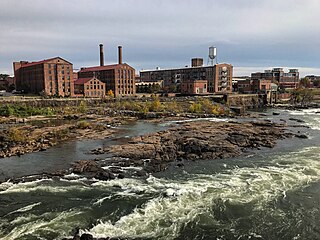
Cusseta is a city in Chattahoochee County, Georgia, United States. It is part of the Columbus, Georgia-Alabama Metropolitan Statistical Area. The population was 11,267 at the 2010 census. The city is the county seat of Chattahoochee County, with which it shares a consolidated city-county government. Despite this, Cusseta is not coterminous with the county; it remains a geographically distinct municipality within the county.

Columbus is a consolidated city-county located on the west-central border of the U.S. state of Georgia. Columbus lies on the Chattahoochee River directly across from Phenix City, Alabama. It is the county seat of Muscogee County, with which it officially merged in 1970. Columbus is the second most populous city in Georgia, and fields the state's fourth-largest metropolitan area. At the 2020 census, Columbus had a population of 206,922, with 328,883 in the Columbus metropolitan area. The metro area joins the nearby Alabama cities of Auburn and Opelika to form the Columbus–Auburn–Opelika Combined Statistical Area, which had an estimated population of 486,645 in 2019.

The Chattahoochee River forms the southern half of the Alabama and Georgia border, as well as a portion of the Florida and Georgia border. It is a tributary of the Apalachicola River, a relatively short river formed by the confluence of the Chattahoochee and Flint rivers and emptying from Florida into Apalachicola Bay in the Gulf of Mexico. The Chattahoochee River is about 430 miles (690 km) long. The Chattahoochee, Flint, and Apalachicola rivers together make up the Apalachicola–Chattahoochee–Flint River Basin. The Chattahoochee makes up the largest part of the ACF's drainage basin.

Horace King was an African-American architect, engineer, and bridge builder. King is considered the most respected bridge builder of the 19th century Deep South, constructing dozens of bridges in Alabama, Georgia, and Mississippi. King was born into slavery on a South Carolina plantation in 1807. A slave trader sold him to a man who saw something special in Horace King. His owner, John Godwin taught King to read and write as well as how to build at a time when it was illegal to teach slaves. King worked hard and despite bondage, racial prejudice and a multitude of obstacles, King focused his life on working hard and being a genuinely good man. King built bridges, warehouses, homes, and churches. Horace King became a highly accomplished Master Builder and he emerged from the Civil War as a legislator in the State of Alabama. Affectionately known as Horace “The Bridge Builder” King and the "Prince of Bridge Builders," he also served his community in many important civic capacities."
The following is a timeline of the history of Charlotte, North Carolina, United States.
The following is a timeline of the history of Lexington, Kentucky, United States.

State Route 103 (SR 103) is a 13.9-mile-long (22.4 km) state highway in the west-central part of the U.S. state of Georgia. The highway travels from a point northwest of Mulberry Grove northwest to West Point. The highway used to travel through Muscogee, Chattahoochee, and Marion counties, but was truncated through Fort Benning. Its former path was redesignated as parts of SR 137 Spur, SR 357 and SR 219.
The following is a timeline of the history of the city of Jackson, Mississippi, USA.
The following is a timeline of the history of the city of Nashville, Tennessee, United States.
The following is a timeline of the history of the city of Mobile, Alabama, USA.
The following is a timeline of the history of the city of Jacksonville, Florida, USA.
The following is a timeline of the history of Savannah, Georgia, United States.
The following is a timeline of the history of the city of Atlanta, Georgia, United States.
The following is a timeline of the history of the city of Chattanooga, Tennessee, United States.
The following is a timeline of the history of Washington, D.C., the capital city of the United States.
The following is a timeline of the history of the city of Wheeling, West Virginia, US.
The following is a timeline of the history of the city of Laredo, Texas, USA.
The following is a timeline of the history of the city of Shreveport, Louisiana, USA.
The following is a timeline of the history of the city of Augusta, Georgia, USA.
The following is a timeline of the history of the city of Buffalo, New York, United States.





